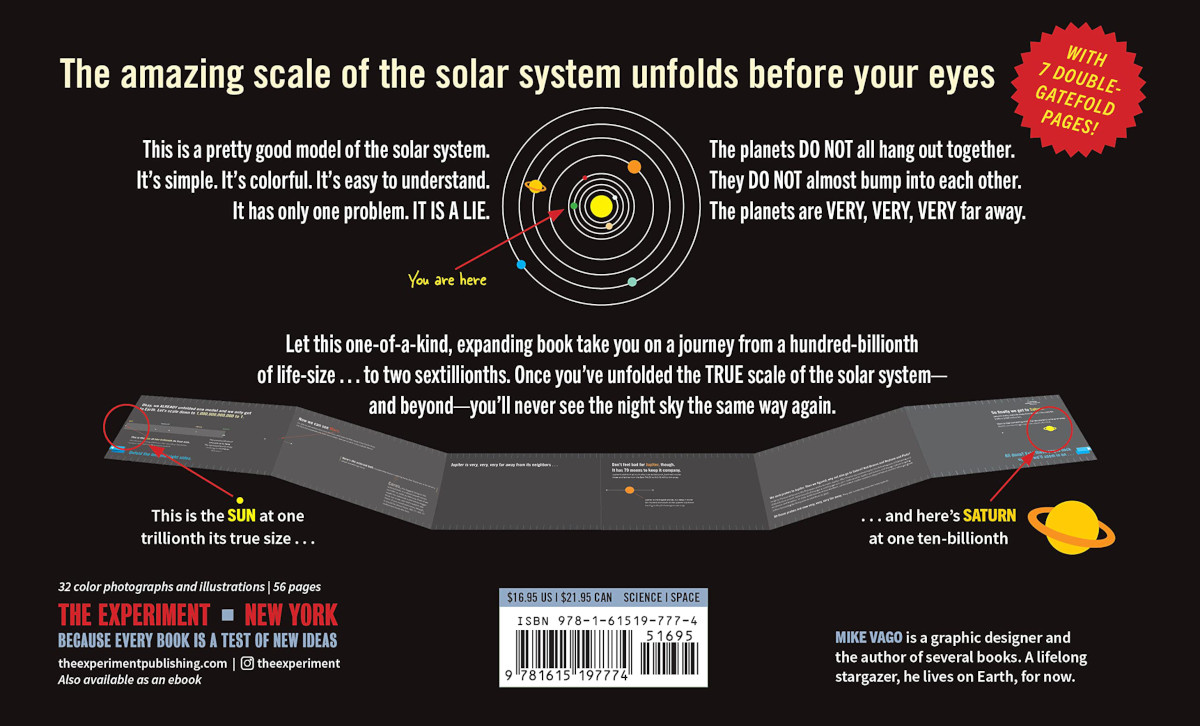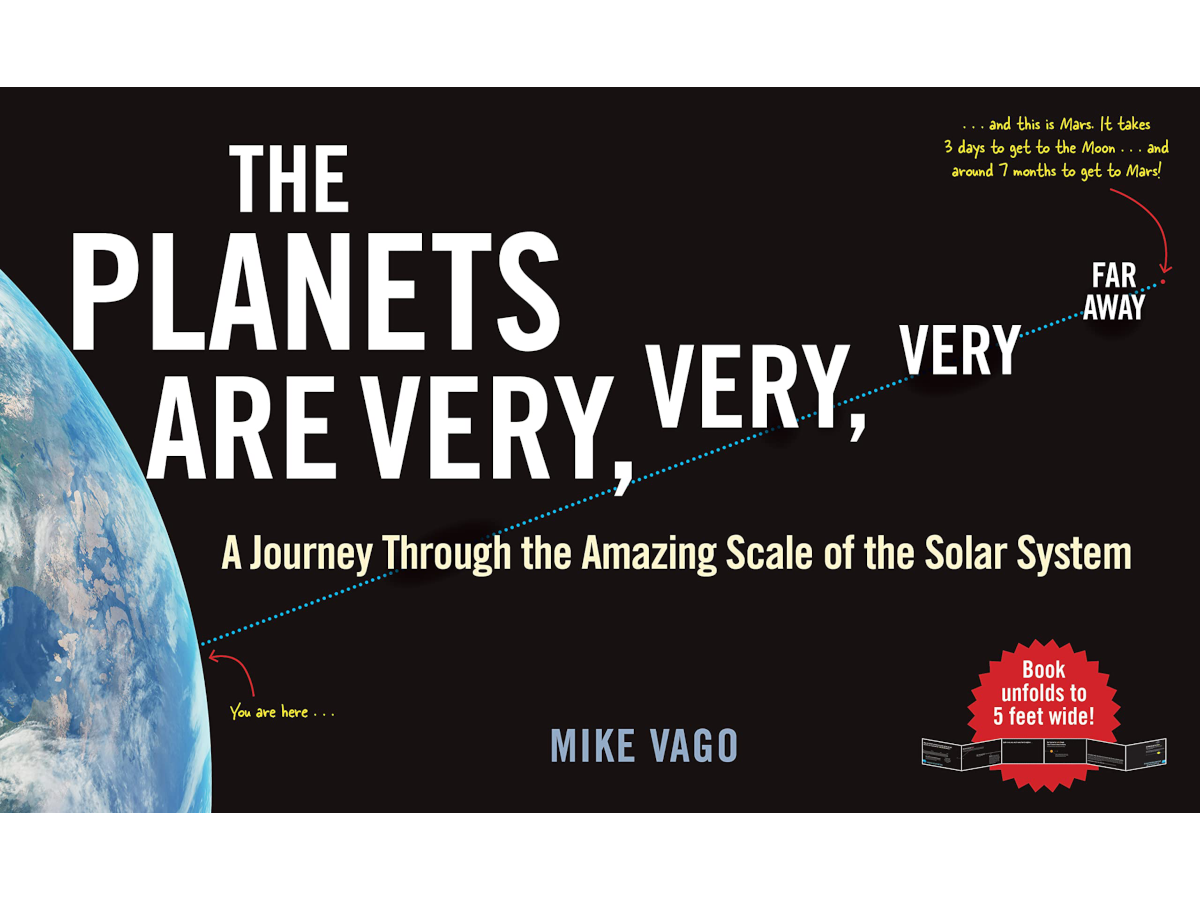One of the best things about reviewing for GeekDad is the lovely book post I receive. It’s an absolute privilege to read and review books ahead and around publication date, and I love doing it. Possibly even better than when a review copy arrives is when slipped inside the envelope with the requested title, is a book unlooked for. Especially, if that book is an absolute gem. This is the case for The Planets are Very Very Very Far Away, by Mike Vago.
What is The Planets are Very Very Very Far Away?
There are a number of similar books and YouTube videos to The Planets are Very Very Very Far Away, all based on an idea that I will never tire of – How to show the vastness of the universe? Subtitled “A Journey Through the Amazing Scale of the Solar System,” the book aims to show just how far planets and other celestial bodies are apart. It does that and a whole lot more.
Planets and stars are topics that fire young inquisitive minds. This book taps into this passion and then boosts it by adding fold-out pages. There’s something about presenting information in a tactile fashion that grips younger readers (much like the recently reviewed Questions and Answers About Money). The Planets are Very Very Very Far Away achieves this tactile component by using pages that fold out to become 5 feet wide.

Why Read The Planets are Very Very Very Far Away?
Demonstrating just how far away the planets are is very difficult. The distances involved are almost incomprehensible. This book makes a very good job of helping us understand. It starts out by explaining how scale works, using a chair, an elephant, and the Eiffel Tower.
It then shows a picture of the Sun at a 10,000,000,000: 1 scale. This page unfolds to the left, twice, giving three panels. The Sun is on the far left of the page, and we find Mercury a surprising 58cm away. The tiny dot that is Mercury, the book explains, is actually 10 times bigger than it should be for the given scale. If it wasn’t we wouldn’t be able to see it. The Sun at the far end of the page is about the size of a dime. The book unfolds another 3 pages and on page 5 we see Venus, and on page 6, some 1.5m away from the Sun, we have Earth.
We’ve used 6 pages and still only found 3 planets. The scale of the Solar System is starting to become apparent.
We continue to go boldly.
Before we do, however, we’re treated to a breakdown of the 4 inner planets, with lots of physical information, and a description of the possibilities of humans living there. We also have a helpful explanation of orbital ellipses and how planets move closer and further apart as they rotate around the Sun.
Next, we move to a 1 trillion: 1 scale and another 6-leaf pullout which enables us to see Mars, the asteroid belt, Ceres, and, right across the other side of the page, Jupiter and Saturn. Before we move to the 10 trillion: 1 scale, we’re treated to a description of the remaining planets and some advanced talk about orbits; they’re not all in a flat plane, you know.
By this point, we’ve sort of finished the standard Solar System fare, with Pluto still being the elephant in the room for many of us (though not those who have read How to to Teach Grown Ups About Pluto). When we talk about Pluto we have to consider oval orbits and dwarf planets. Just what, and how are away are Makemake and Eris? Which of them, if any, rhyme with cake? There’s loads of great information here about the fringes of the solar system.
But that’s not all…
Where does the Solar System finish, exactly? When is a rock, a rock, and when is it a planet? Two questions posed by the book. How many dwarf planets might be out there? What and where is Sedna?
Why not keep going? How far to the stars? How many are within 10 light-years of Earth? By now the book is a scale of 100 quadrillion: 1 and our tiny minds are boggled. There’s even one last treat, that goes even further away, leaving you feeling very small, but also in awe and the sheer size and scope of the universe.
The Planets are Very Very Very Far Away is an excellent book. One that has a mission and 100% succeeds at completing it. If you’re looking to inspire your children to the wonders of the Solar System, this is an excellent and innovative way to do so. Many books have the information gathered in this book, but very few, if any, can convey the sheer scale of our small corner of the universe*.
* Note: It’s not actually a corner.
If you’d like to pick up a copy of The Planets are Very Very Very Far Away you can do so here, in the US, and here, in the UK.
If you enjoyed this post, do check out my other book reviews, here.
Disclosure: I received a copy of this book in order to write this review.



